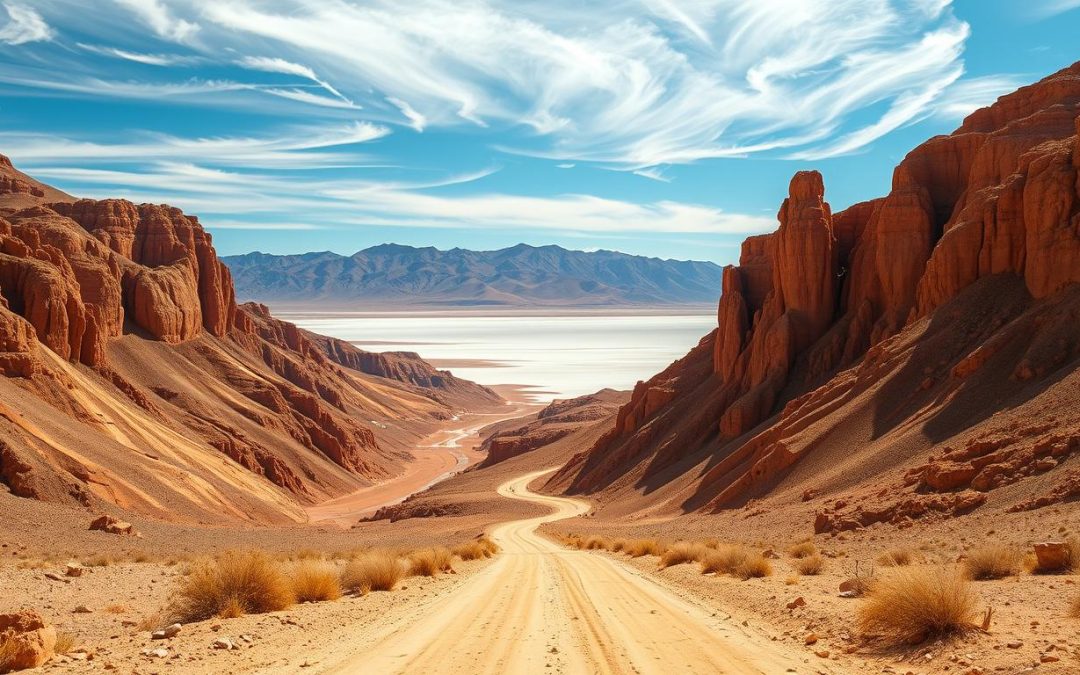Have you ever wondered what makes a desert landscape so captivating? Imagine vast salt flats, colorful canyons, and towering dunes stretching as far as the eye can see. This is the essence of one of the most unique places in the United States.
From the lowest point in North America to scenic drives that showcase nature’s artistry, this area offers experiences you won’t find anywhere else. Whether you’re planning a short visit or an extended trip, there’s something here for everyone.
Ready to discover what makes this destination so special? Let’s dive into the highlights that make it a must-visit for adventurers and nature lovers alike.
Key Takeaways
- Explore the iconic Badwater Basin, the lowest point in North America.
- Hike through the stunning Golden Canyon for breathtaking views.
- Drive along Artist’s Drive to see colorful mineral-rich hills.
- Visit Zabriskie Point for panoramic vistas of the badlands.
- Plan your trip to include both scenic drives and rewarding hikes.
Introduction to Death Valley National Park
What comes to mind when you think of a desert? Vast emptiness or endless beauty? Death Valley National Park defies expectations, offering a landscape that’s as diverse as it is extreme. Known for its harsh conditions, this area is also home to some of the most breathtaking vistas and unexpected natural wonders in the United States.
Covering over 5,000 square miles, this national park is the largest outside of Alaska. Its vastness includes salt flats, towering dunes, and colorful canyons. Despite its reputation for extreme heat, the park’s environment fosters unique ecosystems and geological formations.
One of its most iconic features is Badwater Basin, the lowest point in North America. This salt flat stretches endlessly, creating a surreal landscape. But the park’s diversity doesn’t stop there. From the vibrant hues of Artist’s Palette to the panoramic views at Zabriskie Point, every corner tells a story.
Historically, this area has been a place of resilience and discovery. Native tribes, pioneers, and miners have all left their mark. Today, it’s a haven for adventurers and nature lovers alike. Whether you’re drawn to its stark beauty or its hidden treasures, this park promises an unforgettable experience.
As you explore further, you’ll find that this valley national treasure is more than just a desert. It’s a testament to nature’s ability to thrive in the most unexpected places. Ready to dive deeper? Let’s uncover what makes this destination truly one-of-a-kind.
The Unique Geology and Landscapes of Death Valley
Every rock and dune here tells a tale of time and transformation. The dramatic landscape is a result of millions of years of geological activity. From colorful canyon walls to vast salt flats, the scenery is as diverse as it is breathtaking.
One of the most striking features is the interplay of vibrant colors in the rock formations. The desert terrain showcases hues of red, gold, and purple, created by mineral deposits and erosion. These patterns are especially visible along Artist’s Drive, where the hills seem to come alive with color.
Wind and water have played a significant role in shaping this landscape. Over time, they’ve carved out narrow canyons and sculpted towering sand dunes. The result is a terrain that feels both ancient and ever-changing.
Understanding the geology adds depth to your visit. Each formation tells a story of the Earth’s history. Whether you’re exploring the winding paths of Mosaic Canyon or marveling at the endless stretches of sand dunes, you’ll gain a new appreciation for this unique environment.
This desert is more than just a barren expanse. It’s a living testament to the forces that shape our planet. As you travel along the scenic roads, you’ll witness a world that’s both harsh and beautiful, a true masterpiece of nature.
Planning Your Visit to the Desert Playground
To make the most of your desert adventure, knowing the best times to visit is key. The desert’s extreme conditions vary by season, so planning ahead ensures a comfortable and enjoyable trip.
Winter and early spring are ideal for exploring. Temperatures range from 65°F to 70°F, making it perfect for outdoor activities. Summer, however, can be harsh, with temperatures exceeding 120°F. If you visit during this time, plan activities for early mornings or late evenings.
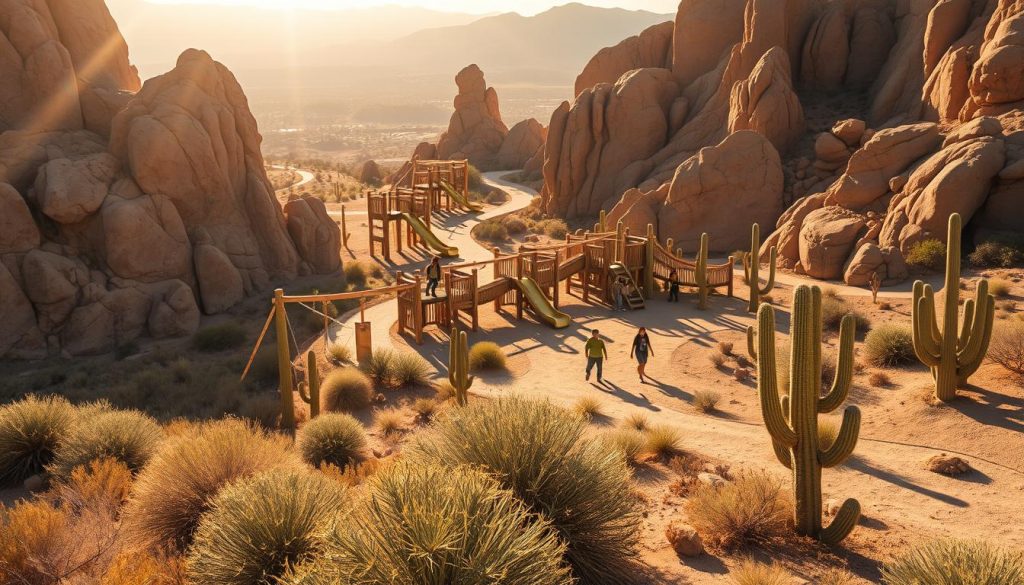
When it comes to getting around, your choice of vehicle matters. While most roads are accessible by standard cars, some routes require high-clearance or 4WD vehicles. Always check road conditions before you drive.
Here’s a quick guide to travel times within the park:
| Route | Distance | Estimated Time |
|---|---|---|
| Furnace Creek to Badwater Basin | 17 miles | 30 minutes |
| Artist’s Drive Loop | 9 miles | 45 minutes |
| Twenty Mule Team Canyon | 2.7 miles | 30 minutes |
For a single day visit, focus on highlights like Badwater Basin and Zabriskie Point. If you have more time, consider a multi-day itinerary to explore hidden gems and scenic drives.
Packing essentials like water, sunscreen, and a map is crucial. The desert can be unpredictable, so prepare for sudden weather changes. A flexible itinerary allows you to adapt to conditions and make the most of your trip.
By planning your days carefully and choosing the right way to explore, you’ll create unforgettable memories in this stunning desert playground.
Death Valley National Park, Nevada: Best Things to Do – Top Picks
Ever dreamed of exploring a land where nature’s extremes create unforgettable beauty? This iconic place offers a mix of adventures that cater to every interest. From towering dunes to panoramic points, there’s something here for everyone.
Start your journey with a hike through Golden Canyon. The trail winds through colorful rock formations, offering stunning views at every turn. For a scenic drive, Artist’s Palette is a must-see. Its vibrant hills are a photographer’s dream.
Don’t miss the chance to visit Zabriskie Point. This lookout provides sweeping vistas of the badlands, especially during sunrise or sunset. It’s a point that captures the essence of this unique place.
Here’s a quick guide to help you plan your day:
| Activity | Location | Travel Time |
|---|---|---|
| Golden Canyon Hike | Near Furnace Creek | 10 minutes |
| Artist’s Drive | Scenic Loop | 45 minutes |
| Zabriskie Point | Badlands Vista | 15 minutes |
Whether you’re hiking, driving, or simply soaking in the views, this place promises an adventure like no other. Ready to dive deeper? Stay tuned as we explore each highlight in detail.
Iconic Hiking Trails and Adventures
Exploring the desert on foot offers a unique way to connect with nature’s raw beauty. One of the most rewarding experiences is hiking through Golden Canyon and the Gower Gulch Loop. This trail combines stunning scenery with a moderate challenge, making it a must-do for adventurers.
Golden Canyon and Gower Gulch Loop
The Golden Canyon trail is known for its golden rock walls and intricate pathways. As you hike, you’ll be surrounded by towering canyon walls that glow in the sunlight. The trail connects to the Gower Gulch Loop, adding variety and extending the adventure.
This 6.4-mile loop is a moderate hike with an elevation gain of 1,082 feet. It’s perfect for those looking to immerse themselves in the desert’s beauty. Along the way, you’ll encounter unique rock formations and panoramic views that are worth every step.
Exploring Desert Canyons and Trails
Desert canyons offer a mix of challenge and reward. The Golden Canyon trail is just one example of the many paths you can explore. Each trail has its own character, from narrow pathways to open vistas.
Here are some tips to make the most of your hike:
- Start early to avoid the midday heat.
- Bring plenty of water and wear sturdy shoes.
- Take breaks to enjoy the views and capture photos.
For a quick reference, here’s a summary of the Golden Canyon and Gower Gulch Loop:
| Feature | Details |
|---|---|
| Distance | 6.4 miles (loop) |
| Elevation Gain | 1,082 feet |
| Difficulty | Moderate |
| Best Time to Hike | Early morning or late afternoon |
Whether you’re an experienced hiker or new to desert trails, this adventure is a thing you won’t want to miss. Lace up your boots, hit the trail, and discover the magic of these desert canyons.
Exploring Badwater Basin and Salt Flats
Step into a world where the ground beneath your feet feels like another planet. Badwater Basin is not just the lowest point in North America; it’s a surreal landscape of endless salt flats that stretch as far as the eye can see. The intricate salt formations here are a testament to nature’s artistry, shaped by centuries of evaporation and geological activity.
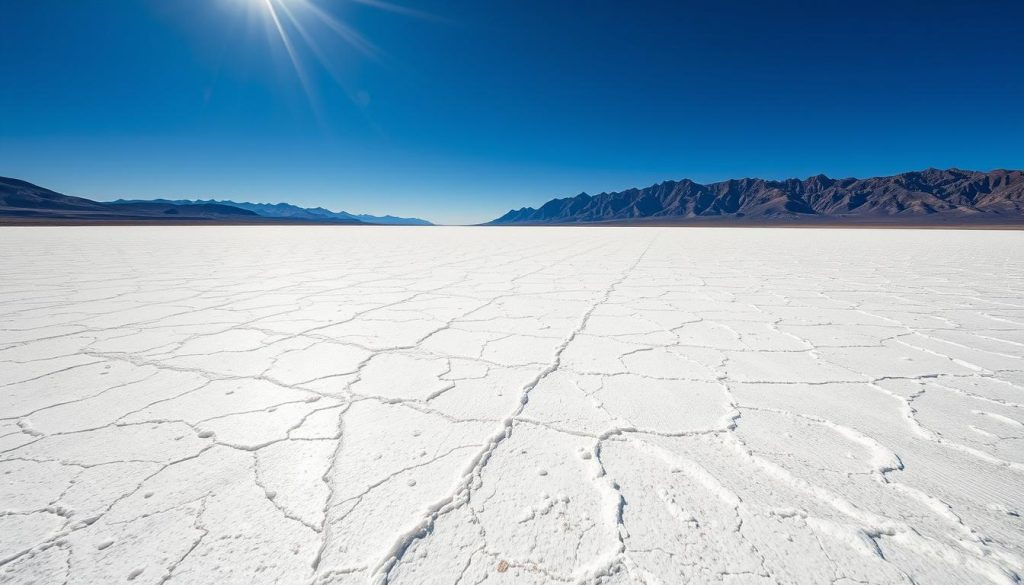
Understanding the Salt Formations
The salt flats at Badwater Basin are a marvel of natural science. Over time, water evaporates, leaving behind a crust of salt that forms unique polygonal shapes. These patterns are constantly changing, influenced by the heat and light of the desert sun. For photographers and hikers alike, the ever-shifting landscape offers endless opportunities to capture its beauty.
When and How to Visit
Timing is everything when visiting Badwater Basin. The best times to explore are early morning or late afternoon, when the light enhances the salt flats’ textures and colors. Avoid midday visits, as the heat can be extreme, with temperatures often soaring above 120°F.
Here are some tips for a safe and enjoyable visit:
- Bring plenty of water—at least one gallon per person.
- Wear sun protection, including a hat and sunscreen.
- Plan your visit during cooler months, like January or February.
Nearby, Furnace Creek serves as a convenient hub for park visitors. It’s a great place to rest and refuel before or after your adventure. Whether you’re here for the photography, the geology, or simply the experience, Badwater Basin promises a journey unlike any other.
Experiencing Scenic Drives and Colorful Roads
Discover a route that transforms the desert into a canvas of vibrant hues. Artist’s Drive is a one-way journey through multicolored hills, offering a visual feast at every turn. This scenic drive is a must for anyone visiting the area, combining ease of access with breathtaking views.
Artist’s Drive and Artist’s Palette Highlights
The highlight of this drive is Artist’s Palette, where mineral-rich hills showcase shades of green, purple, and gold. These colors are the result of volcanic activity and erosion, creating a landscape that feels almost otherworldly. Stop at designated lookouts to fully appreciate the textures and hues.
Exploring this route by car is both comfortable and convenient. The drive is short but packed with photo opportunities, making it perfect for travelers of all ages. Nearby Furnace Creek serves as a great starting point, offering amenities before you hit the road.
Route Planning for a Scenic Journey
To make the most of your trip, plan your drive during cooler hours, like early morning or late afternoon. This ensures better lighting for photography and a more pleasant experience. Here are some tips for your journey:
- Bring plenty of water and sun protection.
- Check road conditions before heading out.
- Allow time for stops at lookouts and photo spots.
For those combining this drive with other activities, Badwater Basin is just a short distance away. This makes it easy to create a full day of exploration. Whether you’re a photographer, nature lover, or casual traveler, this scenic route promises an unforgettable experience.
Capturing Epic Views: Zabriskie Point & Dante’s View
What if you could stand at the edge of the world and see it all unfold before your eyes? At Zabriskie Point and Dante’s View, this dream becomes a reality. These iconic spots offer some of the most breathtaking panoramas you’ll ever witness, making them must-visit destinations for photographers and nature lovers alike.
Zabriskie Point is renowned for its layered textures and golden hues. The badlands stretch out like a painting, with every ridge and valley telling a story of time and erosion. It’s no wonder this spot is one of the most photographed in the area. Whether you visit at sunrise or sunset, the light transforms the landscape into a masterpiece.
In contrast, Dante’s View offers a completely different perspective. Perched high above the valley floor, this viewpoint provides a sweeping view of the vast expanse below. On a clear day, you can see for miles, with the salt flats and mountains creating a dramatic backdrop. It’s a place where you can truly grasp the scale of this unique environment.
To capture the best photos, timing is key. Early mornings and late afternoons offer soft, warm light that enhances the colors and textures. Bring a tripod for stability and experiment with different angles to highlight the unique features of each viewpoint.
Here’s a quick comparison to help you plan your visit:
- Zabriskie Point: Best for sunrise, golden badlands, and layered textures.
- Dante’s View: Ideal for panoramic vistas, valley floor views, and dramatic contrasts.
Both spots are easily accessible, making them perfect additions to your itinerary. Whether you’re a seasoned photographer or simply looking to soak in the beauty, these views will leave you in awe. Don’t forget to bring water, sunscreen, and a sense of adventure as you explore these iconic locations.
Discovering Hidden Gems in the Park
Have you ever felt the urge to escape the crowds and find solitude in nature? Beyond the well-known landmarks, this vast valley holds secret spots that offer peace and unexpected beauty. These hidden gems are perfect for those who want to explore off the beaten path.
One such place is a secluded creek tucked away in a quiet corner of the desert. Here, the sound of flowing water contrasts with the surrounding silence, creating a serene oasis. It’s a refreshing escape from the heat and a reminder of nature’s surprises.
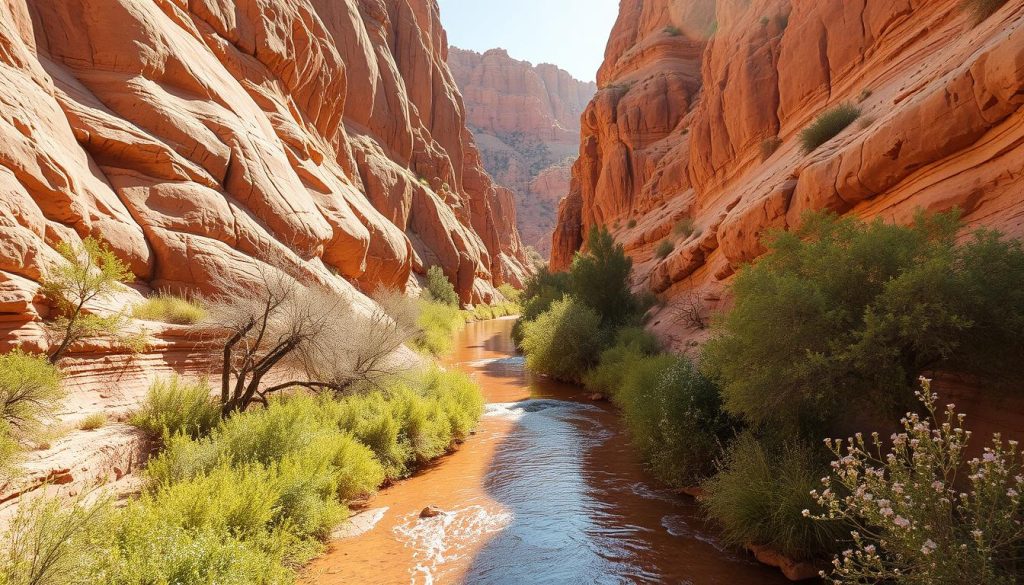
Another hidden treasure is a small desert pocket filled with vibrant wildflowers during the spring. This spot is often overlooked, but it’s a lot more colorful than you’d expect in such a harsh environment. It’s a testament to the resilience of life in the desert.
Exploring these lesser-known areas provides a refreshing contrast to the park’s popular attractions. While places like Badwater Basin and Zabriskie Point are stunning, there’s something special about discovering your own hidden gem. It’s a chance to connect with the landscape on a deeper level.
As you traverse the winding roads, don’t be afraid to make spontaneous stops. You never know what you might find—a quiet creek, a secluded viewpoint, or a patch of wildflowers. These moments of discovery are what make the valley so magical.
So, pack your sense of adventure and set out to uncover the park’s hidden treasures. Whether it’s a quiet lot or a secluded trail, these spots offer a unique perspective on this incredible landscape. The valley is full of surprises—you just have to know where to look.
Tips for Safe and Enjoyable Desert Travel
Exploring the desert safely requires a bit of preparation and knowledge. The unique challenges of this environment make it essential to plan ahead. Whether you’re driving through remote roads or hiking under the sun, these tips will help you stay safe and enjoy your adventure.
First, ensure your car is ready for the journey. Check your vehicle’s condition, including tires, fluids, and fuel. Some roads may require high-clearance or 4WD vehicles, so research your route beforehand. Always carry a spare tire, jumper cables, and a basic repair kit.
Hydration is critical in the desert. Bring at least one gallon of water per person per day. Pack sunscreen, a wide-brimmed hat, and lightweight clothing to protect yourself from the sun. Even in cooler months, the desert sun can be intense.
Stick to designated areas to avoid getting lost or damaging the fragile ecosystem. Use reliable maps or GPS, as cell service can be limited. Always let someone know your plans and expected return time.
Finally, follow Leave No Trace principles. Pack out all trash, stay on marked trails, and respect wildlife. By being mindful of your impact, you help preserve this unique environment for future visitors.
With a bit of preparation and awareness, your desert travel can be both safe and unforgettable. Respect the fragile area, stay hydrated, and ensure your car is ready for the adventure ahead.
Crafting the Perfect Itinerary for Your Trip
Planning a trip to a vast desert landscape can feel overwhelming, but with the right itinerary, it’s a breeze. Start by mapping out your must-see spots and allocating time for each activity. Whether you’re here for a day or a week, a balanced plan ensures you don’t miss the highlights.
For a one-day visit, focus on key attractions like Badwater Basin and Zabriskie Point. Begin early to avoid the midday heat and crowds. Allocate about an hour for each stop, leaving room for scenic drives and short hikes.
If you have more time, consider a multi-day adventure. Spend one day exploring the salt flats and canyons, and another on scenic drives like Artist’s Palette. Include rest stops to enjoy the views and recharge. This approach lets you experience the desert at a relaxed pace.
Here’s a sample one-day itinerary:
- Sunrise at Zabriskie Point (1 hour)
- Drive to Badwater Basin (30 minutes)
- Explore the salt flats (1 hour)
- Lunch at Furnace Creek (1 hour)
- Scenic drive along Artist’s Palette (1 hour)
- Sunset at Dante’s View (1 hour)
Adjust your plan based on the season and your interests. In cooler months, you can extend your hikes and drives. During summer, focus on early morning and late afternoon activities to stay comfortable.
By crafting a thoughtful itinerary, you’ll make the most of your visit and create lasting memories in this breathtaking desert landscape.
Essential Packing List and Outdoor Survival Tips
The key to a successful desert trip lies in careful preparation. The remote and rugged environment demands specific essentials to ensure your safety and comfort. Start with the basics: pack at least one gallon of water per person per day. Hydration is critical in the dry, hot climate.
Sun protection is equally important. Bring sunscreen with a high SPF, a wide-brimmed hat, and sunglasses. These items shield you from the intense sun, reducing the risk of heat-related illnesses. Lightweight, breathable clothing is also a must for staying cool during hikes or drives.
A detailed survival kit is another essential. Include a first aid kit, a map or GPS device, and a power bank for charging devices. Navigation tools are crucial, as cell service is limited in remote areas. Even if you plan to stay in a hotel, being prepared for unexpected situations is a smart tip.
For longer hikes, pack snacks, a whistle, and a flashlight. These items ensure you’re ready for emergencies. If you’re exploring areas like mesquite flat sand, sturdy shoes are a must to navigate the uneven terrain comfortably.
Finally, follow Leave No Trace principles. Pack out all trash and respect the fragile ecosystem. By being prepared and mindful, you’ll enjoy a safe and memorable desert adventure. These tips will help you make the most of your trip, whether you’re staying in a hotel or camping under the stars.
Making the Most of Seasonal Changes in Death Valley
The desert transforms dramatically with each season, offering unique experiences throughout the year. From vibrant wildflower blooms in spring to cooler, comfortable temperatures in winter, every visit feels like a new adventure. Understanding these changes helps you plan a trip that aligns with your interests and ensures a memorable experience.
Spring Blooms and Superblooms
Spring is a magical time in the desert. After winter rains, the landscape bursts into life with colorful wildflowers. In some years, rare superblooms occur, painting the salt flats and hillsides with vibrant hues. These events are unpredictable but unforgettable, attracting visitors from around the world.
To witness this natural spectacle, plan your visit between late February and early April. Bring a camera to capture the fleeting beauty of the blooms. Remember to stay on designated trails to protect the delicate ecosystem.
Winter Comfort and Desert Temperatures
Winter offers a stark contrast to the intense heat of summer. Daytime temperatures range from 65°F to 70°F, making it ideal for hiking and exploring. The cooler weather allows you to spend more time outdoors without the discomfort of extreme heat.
This is also the best time to visit iconic spots like Badwater Basin. The salt flats glisten under the winter sun, creating a surreal landscape. Pack layers for chilly mornings and evenings, and enjoy the tranquility of the desert during this quieter season.
By timing your visit to match the season, you’ll experience the desert’s ever-changing beauty. Whether you’re drawn to the vibrant colors of spring or the mild comfort of winter, each season offers its own unique charm.
Accommodations and Camping Options in Death Valley
Finding the perfect place to stay can make or break your desert adventure. Whether you’re looking for luxury or a budget-friendly option, this area offers a variety of choices to suit every visitor’s needs. From cozy inns to sprawling campgrounds, there’s something for everyone.
If you prefer comfort and convenience, consider staying at one of the on-site hotels. The Inn at Death Valley offers upscale accommodations with stunning views, while The Ranch at Death Valley provides a more relaxed, family-friendly atmosphere. Both are located near popular attractions, making them ideal for first-time visitors.
For those who enjoy the outdoors, camping is a fantastic option. The area boasts several campgrounds, including Furnace Creek Campground, which offers amenities like restrooms, showers, and even a pool. If you’re traveling with an RV, Stovepipe Wells RV Park and Panamint Springs Resort provide hookups and dump stations for added convenience.
Here’s a quick comparison of popular lodging options:
- Hotels: Ideal for comfort and proximity to attractions.
- Campgrounds: Perfect for nature lovers and budget travelers.
- RV Parks: Great for those traveling with larger vehicles.
Booking in advance is highly recommended, especially during peak seasons like spring. Popular spots like Furnace Creek fill up quickly, so securing your reservation early ensures you won’t miss out. Nearby alternatives, such as Beatty or Pahrump, also offer excellent accommodations if on-site options are unavailable.
Choosing between camping and a hotel depends on your itinerary and preferences. Camping allows you to immerse yourself in the natural beauty of the area, while a hotel provides comfort and amenities after a long day of exploring. Whichever you choose, planning ahead will enhance your experience.
For reservations, use trusted resources like the national park’s official website or reputable booking platforms. These tools provide up-to-date availability and pricing, helping you find the perfect spot for your stay. With the right preparation, your trip will be as comfortable as it is memorable.
Planning Day Trips from Nearby Cities
Looking for a quick escape from the city to a breathtaking desert landscape? This area is an ideal destination for a day trip from major urban centers like Las Vegas or Los Angeles. With careful planning, you can experience its highlights in just one day.
From Las Vegas, the drive takes about two hours, making it a convenient getaway. If you’re coming from Los Angeles, expect a four-and-a-half-hour journey. Start early to maximize your time and avoid the midday heat. Pack plenty of water, snacks, and sun protection for the road.
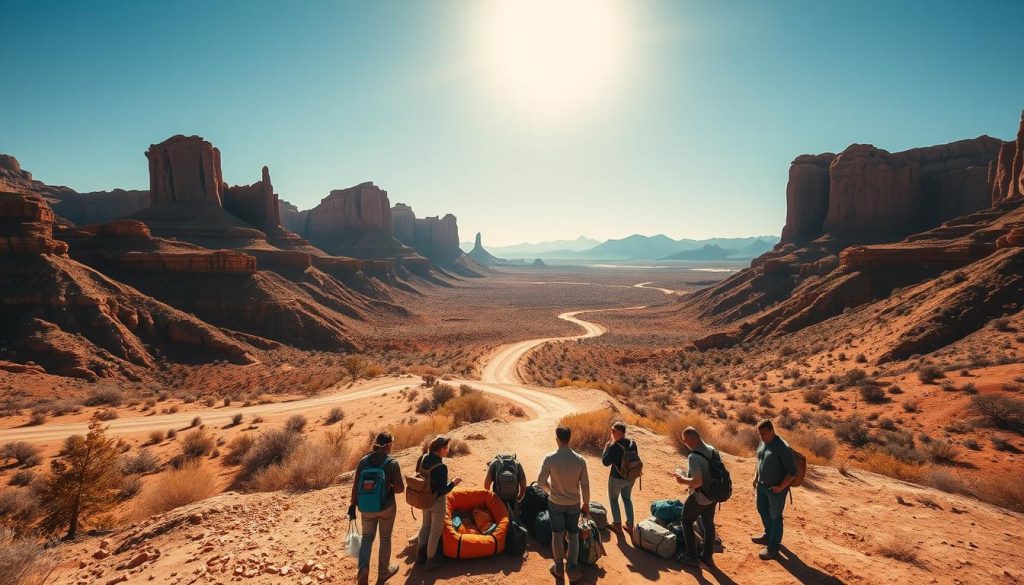
Once you arrive, focus on key attractions like Badwater Basin and Zabriskie Point. These spots offer stunning views and are easily accessible for a short visit. For a scenic route, consider Artist’s Drive, where colorful hills create a memorable backdrop for photos.
Here are some tips to make your day trip smooth and enjoyable:
- Start your drive before sunrise to avoid traffic and heat.
- Plan your route in advance to save time and reduce stress.
- Bring a map or GPS, as cell service can be limited in remote areas.
By following these suggestions, you can make the most of your day and return to the city with unforgettable memories. Whether you’re here for the views, the hikes, or the unique landscapes, this destination promises a rewarding experience even on a short visit.
Conclusion
This destination offers a unique blend of adventure and serenity, making it a place you’ll never forget. From the lowest point in North America to vibrant mineral-rich hills, every moment here is a discovery. Use the itinerary and tips provided to plan your visit the best way possible.
Take your time to soak in the breathtaking views and explore the hidden gems. Whether you’re hiking through golden canyons or driving along colorful roads, every experience is memorable. Share your stories and tips with fellow travelers to inspire their journeys.
No matter when you visit, this destination promises an adventure like no other. Make your way through its diverse landscapes and embrace the magic of the desert. Any time of year, you’ll find something extraordinary waiting for you.
The above is subject to change.
Check back often to TRAVEL.COM for the latest travel tips and deals.
Here are some Tours & Sightseeing suggestions that might pique your interests!
